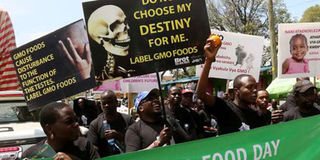No need to reinvent the wheel on GMOs

Activists protest in Nakuru on October 16, 2015 to mark World Food Day and call for the government to tighten biosafety regulations. PHOTO | SULEIMAN MBATIAH | NATION MEDIA GROUP
What you need to know:
- Nobody needs to re-invent the wheel, which is often costly and time consuming with results only confirming what was initially concluded.
- There is enormous data available on MON810 that has been generated over the 20 years it has been commercialised.
On March 9, stakeholders in the biosafety regulatory field launched the Association of National Biosafety Agencies in Africa (ANBAA), in Nairobi.
At the heart of the formation was the desire that the new association would reduce hurdles in sharing and utilisation of data and information between the biosafety agencies to facilitate decision-making on the commercialisation of agricultural biotechnology products.
The push for data sharing comes at a time when most countries undertaking research and commercialisation of agricultural biotechnology products are either not aware of or are not comfortable with building on what has already been generated elsewhere to make decisions.
When universal procedures are applied, such as those from the International Organisation for Standardisation, National Institute of Health, the Joint Research Centre of the European Commission, the Organisation for Economic Cooperation and Development as well as Codex Alimentarius Commission, data should be usable wherever such procedures are accepted.
Data sharing is central to all scientific communities.
Nobody needs to re-invent the wheel, which is often costly and time consuming with results only confirming what was initially concluded.
Innovations build on primary data generated in different places as long as the portable data is credible and reliable, peer reviewed, from competent research organisations or even regulatory authorities using information from previous regulatory approvals.
Seven months after the launch of ANBAA, regulatory agencies in Kenya are still demanding new data on events that have already been characterised by certified and globally recognised agencies.
Is it really necessary or is it a case of reinventing the wheel?
A case in point is the joint application by the African Agricultural Technology Foundation and the Kenya Agricultural and Livestock Research Organisation for the commercial release of the MON810 maize — a genetically modified maize resistant to stem borers.
BIOSAFETY REGULATIONS
The big question is whether all the information required in the prescribed form should be generated afresh and how much of the publicly available data is admissible.
The MON810 maize is commonly cultivated in released varieties across the globe and has been commercialised for 20 years.
There is enormous data available on MON810 that has been generated over the 20 years it has been commercialised. Is there still a need to start from scratch? No.
While data requirement for environmental release of a characterised event differ from application to application, there are general sets of data that are required universally that can be shared.
In addition, a number of events proceeding to commercialisation will already be well-characterised and the host as well as the donor organism well understood.
Ironically, Kenya is one of the countries that permit data portability.
Section 28 of the Kenyan Biosafety Act. No 2 of 2009 clearly states: “The National Biosafety Authority may opt not to undertake a risk assessment… where it determines that sufficient experience or information exists.”
Section 5(3) of the environmental release regulations also states: “An applicant may refer to data or results from an application previously submitted by another applicant, provided the information, data and results are non-confidential or such applicants have given their agreement in writing.”
However, even where regulatory authorities may want data regenerated in their jurisdictions, they must have a clear rationale and expected outcome that is different from the previous studies or experiments, and sufficient reason as to why the applicant needs to conduct further trials when this has already been done in a similar ecological zone.
The ANBAA should live up to its overall spirit to ease the biosafety regulatory environment in Africa.
Wandera Ojanji comments on scientific issues. [email protected]




